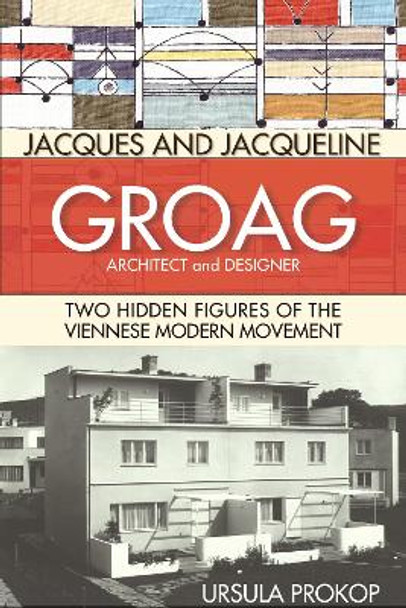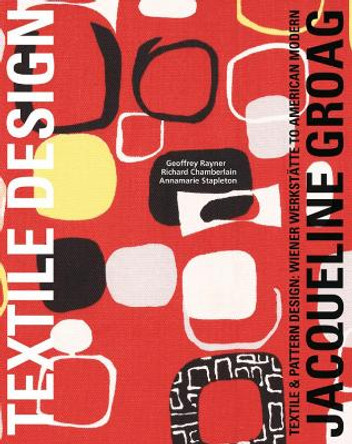Description
Prokop's meticulous history restores Jacques and Jacqueline Groag to their rightful places in the pantheon of Viennese Modernists.
Prokop explores their individual careers in Vienna and Czechoslovakia, their early collaborations in the 1930s, their lives as Jewish emigres, and the couple's unique contributions in Britain for postwar exhibitions, monuments, furniture and textile design, even a dress for future-queen Elizabeth II. Full color edition, supported by a grant from the Graham Foundation for Advanced Studies in the Fine Arts.
Pre-pub finished review copies sent to select bookstores and reviewers
DRCs on Edelweiss
Tailored campaign to academic and museum audiences
Social media campaign
Excerpt on The Nomadic Journal
ollaboration with The Initiative for Architecture and Design on Film for a "Design Onscreen" film, which would be pitched to Netflix, Amazon, PBS, and others (tbd)
About the Author
Ursula Prokop is a Viennese art and architecture historian who has written several books and regularly lectures on her research in the field of architecture and cultural history in the first half of the 20th century. She has contributed to numerous publications, collaborative studies, and research for exhibitions. In addition to writing the definitive biography and analysis of Jacques and Jacqueline Groag and their work, Das Architekten- und Designer-Ehepaar Jacques and Jacqueline Groag: Zwei vergessene Kunstler der Wiener Moderne (Boehlau 2005), she is the author of a biography of Margaret Stonborough-Wittgenstein (Boehlau 2003), acclaimed by the Frankfurter Allgemeine Sonntagszeitung, Kunstmarkt as a biography that "makes the past come to life in an exciting way." The Neue Zurcher Zeitung called the Stonborough-Wittgenstein book one "of high merit" and "insightful into the lives of the Wittgenstein family," while the review from the Suddeutsche Zeitung found the book exemplary for providing "new contours" not just to the Wittgenstein family story and Margaret, one of the more famous sitters for Gustav Klimt, but to the picture of early-20th-century bourgeoisie life. Prokop's earlier biography of controversial architect Rudolf Perco (Rudolf Perco 1884-1942: From the Architecture of Red Vienna to Nazi Megalomania ; Boehlau 2001) was the first comprehensive biography of this model student of Otto Wagner and Prix-de-Rome winner of 1910. It explored his adventuresome unbuilt designs, his descent into a utopian fantasy of state control, his disenchantment with the Nazis and subsequent disenfranchisement, leading to his suicide in 1942. The Neue Zurcher Zeitung found the book to have "a wealth of facts" and to be "meticulously researched."
Reviews
The Festival of Britain, the third and much the largest of the post-war design bonanzas is now regarded mainly as the start of the mass-public acceptance of the 'modern' design and architecture. ... It opened up the possibilities inherent in designing and influenced the whole development of the modern multi-disciplinary design office. The Festival was British, extravagantly so, ... but it is ironic that many of the main designers of the Festival in the post-war periods had in fact arrived from abroad: Stefan Buzas, Jacques and Jacqueline Groag. ...Where would British design have been without this foreign input?
- Fiona McCarthy/Patrick Nugents, Eye for Industry, Royal Designers 1936-1986
Jacques Groags living spaces exhibit an attitude that abstains from exaggerated "sober" motifs. Next to the purist cheerfulness that is at play, imagination rules, as well as delicate proportions, which are a mental rather than utilitarian matter. This architect has created living spaces that veritably dissolve in light. There is an impulse to open up walls and to take away their material bodies. The fact that Groag came from painting to architecture is apparent via the pictorial effects; it is obvious that he masters the technicalities. ... Almost all of the rooms share a tendency towards delicate fabric covers that dissolve the boundaries of the rooms, a preference for natural-colored floor mats, and for light colors as such.
- Innendekoration
Jacqueline Groag's long life of creativity received its strong foundations from the remarkable period of Viennese Arts and Crafts that - after three generations - we now recognize as the source of much of what European culture has given to the world. As one of the very few pupils of that great teacher, Josef Hoffmann, Jacqueline survived into our time of turbulence and uncertainty to make us understand that our lives are of real value only when we live with beauty.
- Stefan Buzas, Eulogy for Jacqueline Groag, January 21, 1986
The fact is, that [Jacques Groag] was, until the Nazis invaded Austria, one of the leading and most successful avant-garde architects in Vienna, where he was for many years engaged on work for important housing projects, public buildings and private houses. ... In Britain in the absence of any architectural work, he was glad to supply himself to utility furniture. When, after the war, building activities were resumed, no one in Britain seemed to be aware any longer of his caliber as an architect, and Groag himself was much too modest a man to claim what, by rights, ought to have been his due.
- Sir Gordon Russell, SIA Journal
[Jacqueline Groag lives] in a world of imagination. [...] Starlight, with its interweaving of delicate chains, suggests to me marvellous and mysterious talks under the stars. I cannot remember designs for fabrics affecting me in this way before.
- Charles Reilly, Art and Industry
Few designers can move easily from abstract design to the representational and produce equally good work in both disciplines. Jacqueline Groag not only possesses this special gift but also the ability to abstract from life so that reality still exists in many of her patterns, but transformed by the wit and charm of her own personality.
- The Ambassador
Her work [...] in the clarity of its line and colour as much as subject-matter, eluded received notions and never lost an element of child-like wonder, of day dreaming.
- Isabelle Anscombe, author of A Woman's Touch
[Jacqueline Groag] constantly and ingeniously exploited the decorative possibilities of simple motifs, frequently in highly complex designs.
- House and Garden
The art historian Ursula Prokop empathically describes the life of the Groags [...] and characterizes their artistic achievements. The difficulty of finding sources - Groag's buildings have been extensively changed, many of his furniture have been lost or are widely scattered - made the research for the present double biography at first slow and tedious. Nevertheless, the author has managed to convey a multifaceted and vivid picture of [the Groags'] contemporary history, as well as highlighting the influence that the continental avant-garde had on British design of the post-war years and the acceptance of a modern language of form. Thus, the work that emerged in the context of a research project carried out at the University of Vienna is not only a late tribute to the two designers in their old homeland, but also a contribution to the subject of the individual design history that goes beyond individuality.
- Dagmar Steffen, Bauwelt
Ursula Prokop offers an extensively researched book on the Viennese architect and designer couple Jacques and Jacqueline Groag that provides new infor mation and new insight into the lives of two talented artists whose modernist work crossed over political. geographical, and cultural frontiers. [...] The book is a well-documented overview of the couple's lives and works. It introduces biographical material collected and preserved from many different collections, especially those of the two nephews, Mr. Jan Groag in New York and Dr. Willi Groag in Maanit, Israel. [...] This is a pioneering work that rightfully places the artists Jacques and Jacqueline Groag within the field of Viennese Modernism.
- Elana Shapira, Centropa
Moving forward in time throughout the book, I couldn't help wonder if the couple would have been remembered - not "largely forgotten" [as the author states] - if they would have emigrated to the United States, where fellow Austrians R.M. Schindler and Richard Neutra went. I imagine the Austrian-Jewish-emigre version of Charles and Ray Eames. [ ... ] With skills in architecture, interior design, textiles, paintings, and other aspects of art and design, the Groags were capable of creating complete environments.
-A Daily Dose of Architecture
This July Ursula Prokop's well-researched biography of Groag and his wife Jacqueline was published by DoppelHouse Press, bringing to our attention these two important designers who practiced in Austria, Czechoslovakia, and Britain after World War II. [...] The legacy of Jacques Groag lies in helping make Adolf Loos' and Ludwig Wittgenstein's architectural designs possible, producing his own modernist building designs, furnitures and interiors, and contributing an excellent [duplex] at the Werkbundsiedlung in Vienna. Jacqueline Groag is considered one of the most important British postwar designers. Both Jacques and Jacqueline were essential pieces in the multi-faceted Czech and Slovak tapestry of endeavor to enrich the world of art, design and architecture.
- British Czech and Slovak Review
A meticulous excavation of the lives of these two seminal figures in the Viennese modern movement, who, if not entirely lost to history, previously were mere peripheral actors. This book, originally published in German in 2005, has altered the terrain: the Groags are now very much present in the consciousness of scholars in the field. They are hidden no more, and their rediscovery has prompted some reassessment of them and their work, but also of the history of Viennese design.
-Central European History Journal
Ursula Prokop [...] extends her commitment to presenting the interwar environment in Vienna as a leading center of a modern movement wherein Jewish creatives and clients played an important role. ... Prokop has gathered an impressive amount of information and presents a thrilling story of the partially forgotten Groags. (A complete list of the Groags' projects and an accessible bibliography is also useful for resuscitating the pair's design careers.)
- Ladislav Jackson, Design and Culture Journal
Between the two world wars, Vienna was a major hub of creative activity, especially in the fields of painting, architecture, and design. [...] In 1938, the Groags, like many of Vienna's Jewish artists and intellectuals who were not sent to concentration camps, were forced into exile by the Nazi regime. This expulsion not only deprived many people of their homes and livelihoods; it also left Austria bereft of a creative energy that had defined a rich, innovative era there. Ursula Prokop's abundantly illustrated double biography brings these little-known figures and their fascinating work to life.
-The Paper Brigade / Jewish Book Council
Book Information
ISBN 9780999754436
Author Ursula Prokop
Format Hardback
Page Count 272
Imprint DoppelHouse Press
Publisher DoppelHouse Press




